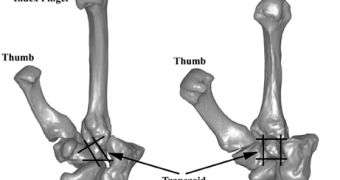You can imagine the shock of the scientists looking in 2003 for traces of ancient human migration from Asia to Australia to stumble onto a new human species where they least expected: the "hobbit" human species discovered on the Indonesian island of Flores. A vivid debate tried to establish whether the "Flores man" was a dwarfish human species or a diseased Homo sapiens.
The grapefruit-size skull made some scientists embrace the theory that the brain belongs to a modern human with a genetic disease called microcephaly that induces small brains.
But a new American-Australian-Canadian-Indonesian research comes with a new proof pointing towards a new species rather a dwarf-like modern human.
"Their wrist bones don't look anything like wrist bones that modern humans and Neanderthals have," said lead author Matthew Tocheri, a paleoanthropologist at the Smithsonian Institution in Washington, D.C.
"The wrist bones are more primitive like those of gorillas, chimpanzees, and other early human ancestors. This suggests the hobbit represents a lineage that appeared before the modern wrist evolved. This is basically something that has descended from an ancestor that probably lived sometime between one and three million years ago. Knowing who that ancestor is must wait until wrist bones for other ancestors are found," said Tocheri.
The most likely ancestor could have been Homo erectus, who about 2 million years ago went out of Africa and reached China and Indonesia, but there could also be a more primitive Australopithecus, still undetected out of Africa.
The particular wrist bone is wedge-shaped in apes and early humans but squared-off in Homo sapiens and Neanderthals. "That wrist bone in the hobbit retains the wedge shape. It was a no-brainer from my perspective," said Tocheri.
"The study makes a convincing case that the wrist bones are primitive." said Chris Stringer, lead researcher in the Human Origins program at the Natural History Museum in London.
This matches previous observations of primitive shoulder joints, foot features and jawbones in the hobbit.
"When you put all this together, you do end up strongly reinforcing the idea that this is indeed a very strange and very primitive kind of creature, not necessarily [in the genus Homo]. Obviously, one has to temper this with admitting that we still need more material." said Stringer.
But the microcephaly hypothesis still stands.
"While the hobbit's wrist bones do appear primitive, the study fails to include a direct comparison of the hobbit's wrist to those of a modern human with microcephaly," said Robert Martin, curator of biological anthropology at the Field Museum in Chicago and co-author of two researches pointing the hobbit as microcephaly diseased modern human.
Microcephaly is known to induce various bone deformations, even in the wrist. But Tocheri's team says that no known genetic malformation, including microcephaly, produces a wrist similar to the hobbit's or those of other primitive ancestral humans. But the mystery of "Flores man" is still unsolved, as scientists would need as-yet-unavailable wrist bones from Homo erectus to see if they match the hobbit or modern humans.

 14 DAY TRIAL //
14 DAY TRIAL //